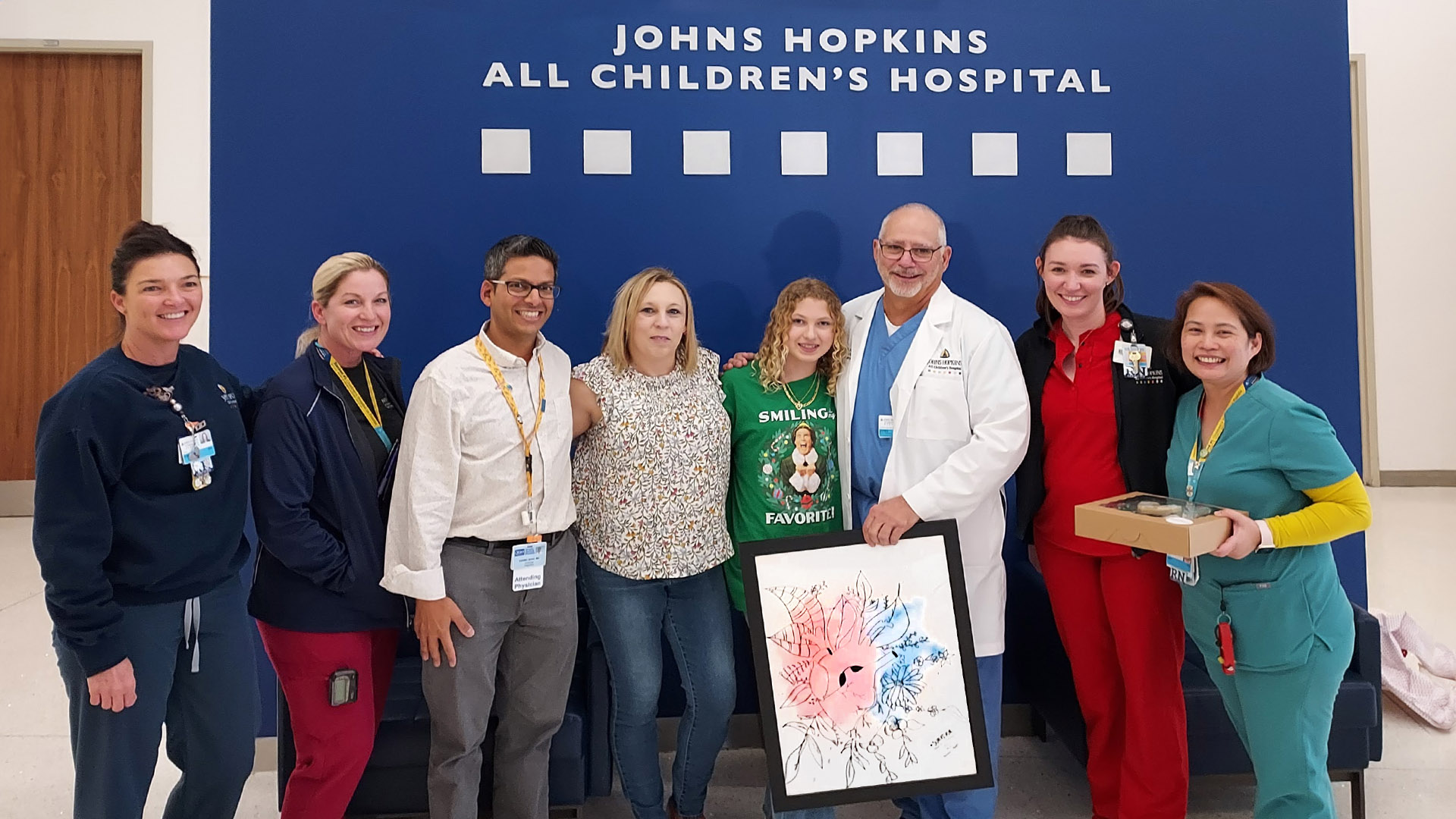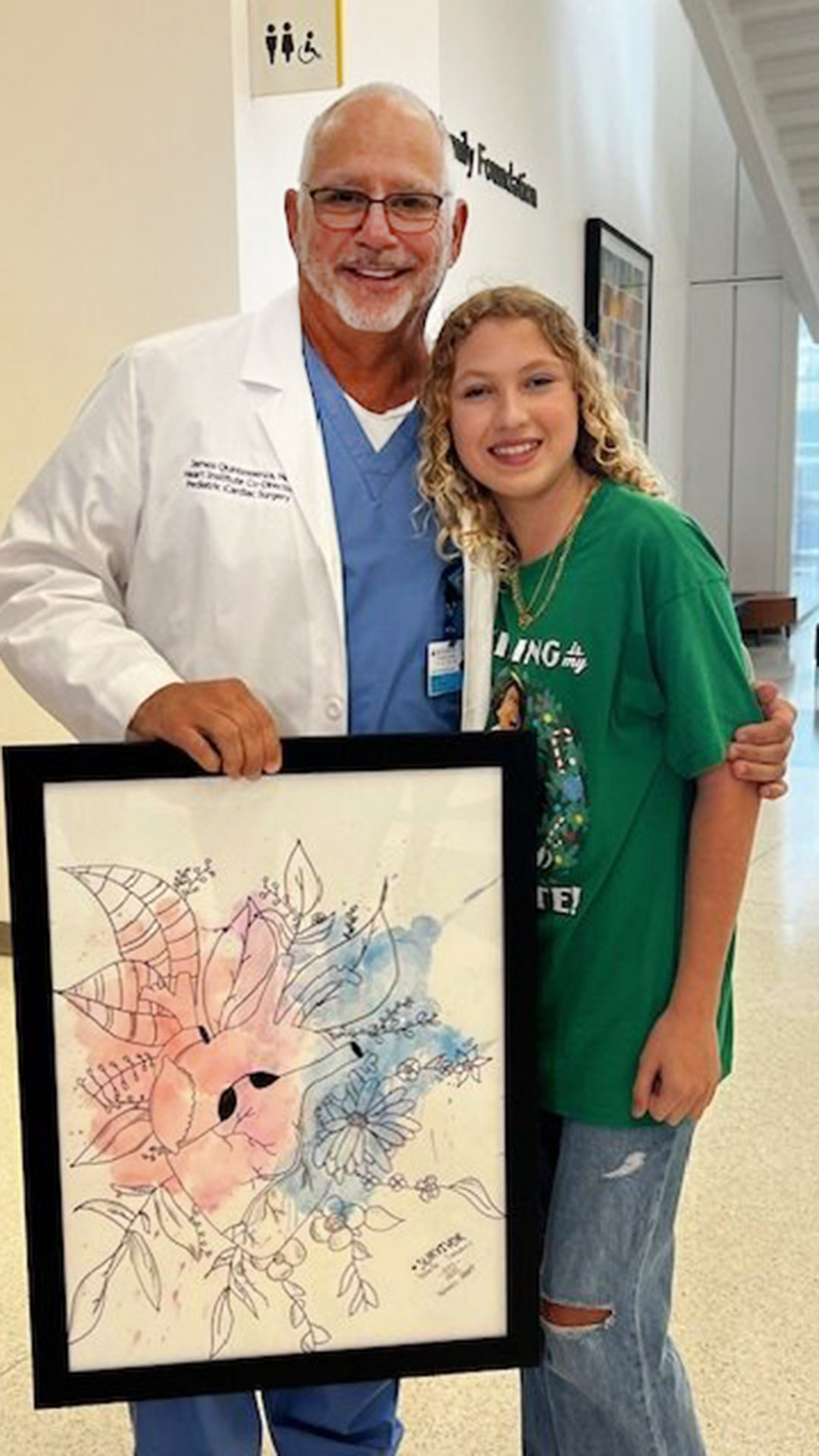Art from the Heart: Bella's Story

Bella could not believe it when she glanced down the hall and saw the doctor who saved her life over 10 years ago. “I knew it was him! I recognized him from pictures my mom showed me,” she says.
The 12-year-old from Lakeland, Florida, had dreamed of meeting James Quintessenza, M.D., the cardiovascular surgeon from Johns Hopkins All Children’s Hospital in St. Petersburg who saved her life. In fact, it was her Christmas wish this past year to meet him and present him with a special piece of art she drew, inspired by her own heart that Quintessenza had repaired.
“I wanted to draw some art for him because I’m good at it,” she says. “So, I drew him my heart, since my blood mixes red and blue, which makes purple, I used watercolors, to recreate it.”
She also wrote him a letter. It read, in part:
“I would not be alive at this exact moment if it wasn’t for you. I always knew deep in my heart that you were there for me.”
Quintessenza was amazed by her drawing and told her he would hang it in his office.
“I get cards and letters from former patients at Christmas, graduation and during special events,” Quintessenza says. “I enjoy that because a lot of times we don’t get to see these patients after they are discharged. It was very gratifying to receive this special gift from Bella and see how she is living a very good life.”
Also on hand for the reunion were other members of cardiovascular intensive care unit (CVICU) who had a part in her surgeries and recovery, including June Morgan, R.N., the clinical manager for the CVICU, who was Bella’s bedside nurse, and Ashish Shah, M.D.,M.B.A., her cardiologist, who conspired with Bella’s mother, Melissa, to make the reunion a reality.
“When she asked me if I could arrange for Bella to meet Dr. Quintessenza, I said – We can do that!” Shah says. “Seeing her meet him and hearing her read that letter had us all in tears.”
“I didn’t recognize her at first because she was a baby when I cared for her,” Morgan says.
“When you realize the impact you have had on these patients and their families, it fills your cup,” Morgan says. “Our job can be both emotionally and physically taxing, but seeing Bella after all these years, gives me joy to know she is doing well, and she has grown up to be an outstanding young lady.”
 Bella sharing the artwork she created for Dr. Quintessenza
Bella sharing the artwork she created for Dr. Quintessenza“I’m glad I got to meet all the doctors and nurses that took care of me,” Bella says. “I was surprised that everyone was crying.”
Bella’s story started in 2011, when Melissa was 20 weeks pregnant. A scheduled ultrasound to determine the baby’s gender revealed that Bella had a rare congenital heart disease, known as “Holmes heart.” It’s when the heart only has a single functional ventricle instead of two ventricles (right and left).
“I remember that day very clearly,” Melissa says. “When the doctor came in the room after the ultrasound, he never said, it’s a girl or it’s a boy. He just said, she has something wrong with her heart. I thought, OK, you said ‘she’ so, YAY, it must be a girl, but what’s wrong with her heart? I was shocked.
“The medical team at my obstetrics practice near our home in Lakeland were not 100 percent sure what type of heart defect she had. But they told me the baby might not make it through the birthing process and if she did, her quality of life would be grim. There was a lot of medical speculation and consultations with many doctors over many days.
“Finally, a cardiologist from Johns Hopkins All Children’s Hospital came over to Lakeland for a consultation. He was the one who diagnosed her with Holmes heart. He recommended we come to St. Petersburg and meet Dr. Quintessenza as soon as possible.”
Quintessenza noted that during his three-decade career caring for thousands of patients, he has only operated on about 10 patients with Holmes heart.
“She’s a good example why you need a very specialized hospital like Johns Hopkins All Children’s that recognizes these medical anomalies and can treat them,” he says.
“I decided we were going to do the surgery and whether or not she is here for a day, a month, a year or 20 years, we are going to put it in God’s hands,” Melissa recalls.
Melissa was encouraged to deliver Bella at Bayfront Baby Place, located within Johns Hopkins All Children’s Hospital, just a short elevator ride to the Johns Hopkins All Children’s CVICU in case Bella needed lifesaving surgery at birth.
Luckily, doctors decided Bella did not need surgery right away. She spent her first couple of weeks of life in the CVICU as planned. After that, Melissa and Bella’s dad, Justin, took her home to help her gain weight before the surgical procedures to correct her heart.
“She was in congestive heart failure, so we were in and out of the ER several times,” Melissa says. “Her oxygen saturations were very low. We were just trying to get her to a point where she would be healthy and strong enough to have surgery.”
Finally, at 12 weeks of age, doctors we able to place a pulmonary artery band that helps restrict blood flow to the pulmonary artery. It's used to correct congenital heart defects in small infants.
Over the course of three open-heart surgeries before the age of 3, Quintessenza, along with a team from the hospital’s Heart Institute, “rearranged Bella’s heart plumbing,” as he called it, so one pumping chamber can do the work of two.
“Normally, you have two pumping chambers in your heart and a patient with Holmes heart only has one functioning pumping chamber,” Quintessenza explains.
Bella’s next surgery, called a Glenn procedure, was done at 9 months of age. It corrected the way blood flowed through her heart. It gave the one fully functioning ventricle relief and helped get more oxygen into the blood. It was the longest of the surgeries, lasting more than nine hours.
Her third and final revision surgery in 2014, just shy of her third birthday, reattached the arteries to allow blood flow to the top of the body and the bottom half to give her the best possible shot at optimal blood flow.
“The three surgeries were successful. Bella has done very well,” Melissa says. “Now we only go to the hospital twice a year to see Dr. Shah for routine check-ups. He checks her exercise capacity, performs an EKG, echocardiogram and a stress test.
“She’s on cruise control,” Shah says. “The expectation is that she will live a very long life. She can continue to play sports and one day, have her own family.”
“Children like Bella would not have survived with a Holmes heart 40-50 years ago. Helping kids like her is what makes me want to come back to work every day,” Quintessenza says. “Look at the quality of her life and what she’s able to do. It’s just phenomenal. I wouldn’t trade my job with anybody’s.”
The Heart Institute at Johns Hopkins All Children's Hospital
Our experts provide comprehensive, compassionate care to children of all ages with congenital heart conditions in the Heart Institute at Johns Hopkins All Children's Hospital in St. Petersburg, Florida. We serve families throughout the greater Tampa Bay area and beyond.
